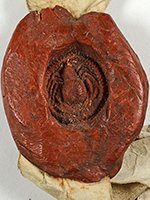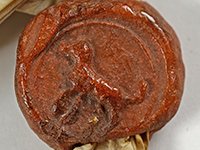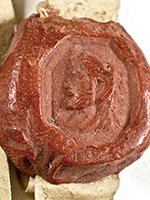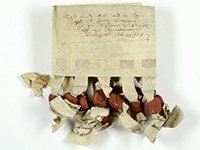 Acres, rods and perches of parchment, pricked, ruled, inscribed and sealed, are carefully preserved at Surrey History Centre. Thickets of 'heretofores', 'witnesseths' and 'whereases' can discourage the eye, and certainly the bristling concatenations of legal phrases which take up much of the parchment area tell us little that is specific. Yet title deeds were probably the most carefully kept possessions of our forebears – hence their survival even today, from up to nearly 800 years ago. The vast Evelyn estate archive, long preserved at Wotton House, documents centuries of landholding in the woods, downs and valleys of south west Surrey. Studying these deeds reveals many stories among the names of the vendors, mortgagees, purchasers and trustees, the circumstances of their title, details of their property and the terms of the deal.
Acres, rods and perches of parchment, pricked, ruled, inscribed and sealed, are carefully preserved at Surrey History Centre. Thickets of 'heretofores', 'witnesseths' and 'whereases' can discourage the eye, and certainly the bristling concatenations of legal phrases which take up much of the parchment area tell us little that is specific. Yet title deeds were probably the most carefully kept possessions of our forebears – hence their survival even today, from up to nearly 800 years ago. The vast Evelyn estate archive, long preserved at Wotton House, documents centuries of landholding in the woods, downs and valleys of south west Surrey. Studying these deeds reveals many stories among the names of the vendors, mortgagees, purchasers and trustees, the circumstances of their title, details of their property and the terms of the deal.
A curiously circuitous description in 1518 of the vendor of the manor farm of Gostrode in Wotton, 'Peter Bardsey, cousin and heir to Thomas Bardsey that is to say brother of the said Edmond Bardsey father unto the said Thomas Bardsey', expresses the unexpected twists of family fortune in the Bardsey family, which the bare facts of individual baptisms and burials don't tell. Here, Peter chanced to inherit from his deceased brother after the early death of his nephew.
 Lady Jane Bray's is a tale of a wicked stepson. In 1577, the widow sold the manor of Westland: as the deed of sale explains, she held the manor for life under the terms of her marriage with Sir Edward Bray, but her husband's son Edward 'interrupted and molested' her ownership by selling her woods, and breaking the head of Vachery Pond in Cranleigh to take her fish. Sir Edward had feared for his wife's future, and provided in his will that in such a case she was free to sell – a most unusual circumstance for a woman.
Lady Jane Bray's is a tale of a wicked stepson. In 1577, the widow sold the manor of Westland: as the deed of sale explains, she held the manor for life under the terms of her marriage with Sir Edward Bray, but her husband's son Edward 'interrupted and molested' her ownership by selling her woods, and breaking the head of Vachery Pond in Cranleigh to take her fish. Sir Edward had feared for his wife's future, and provided in his will that in such a case she was free to sell – a most unusual circumstance for a woman.
On occasion we might be able to identify the property sold with drone-like accuracy, with details of neighbouring land and its owners, and the nature of its boundaries, hedge, posts or ditches. A deed in fine condition from the 13th century records Giles of Westcott's sale over 700 years ago of an acre of land adjoining the road from Guildford to Dorking, next to lands of Gilbert the miller (Westcott Mill) and of the rector of Wotton.
 While leases might be recycled for their valuable parchment at the end of the rental term, others give us scene-setting detail. Edward Elrington's 1574 lease to George Bromell of Abinger manor house and lands notes that goshawks nesting in the woods (fine arboreal hunters) must remain Elrington's. Richard Evelyn leased to Godhelpe Cooper a house called Cockes Corner with gardens and orchard in Ockley in 1631, requiring that he newly build 'a substantial, convenient and fit house for habitation', in return for a rent free year, and to 'plant and graft' 40 fruit trees 'at the least of apples, pears and cherries'.
While leases might be recycled for their valuable parchment at the end of the rental term, others give us scene-setting detail. Edward Elrington's 1574 lease to George Bromell of Abinger manor house and lands notes that goshawks nesting in the woods (fine arboreal hunters) must remain Elrington's. Richard Evelyn leased to Godhelpe Cooper a house called Cockes Corner with gardens and orchard in Ockley in 1631, requiring that he newly build 'a substantial, convenient and fit house for habitation', in return for a rent free year, and to 'plant and graft' 40 fruit trees 'at the least of apples, pears and cherries'.
Two Evelyn tenants, John Williams of Wotton in 1613, and John Kerrell of Abinger in 1640, described themselves as seal makers. Presumably metal workers, they must have had enough local business to claim a specialism in moulding the seal matrices which stamped the distinctive mark of the owner on to soft wax at moment of the deal. As personal symbols, seals of course had many varieties: object, human, animal. What, ingenious or obvious, motivated each owner's choice of design?
 On 26 November 1531, the manor farm of Edmonds, Gomshall, was exchanged before witnesses by 13 trustees, each with his seal, to 13 more, all local men. The densely strung parchment powerfully commemorates the event of the meeting of these contemporaries, friends and neighbours.
On 26 November 1531, the manor farm of Edmonds, Gomshall, was exchanged before witnesses by 13 trustees, each with his seal, to 13 more, all local men. The densely strung parchment powerfully commemorates the event of the meeting of these contemporaries, friends and neighbours.
Deeds, although impersonal and formal, give us access to place, time and people in Surrey's past, and can give tantalising clues to the lives of those whose transactions they record, and the land from which they drew their 'lyvelode' (livelihood).
See also
The history and conservation of seals
Images
Select image to view a larger version.
- Spider seal of John Shenfelde, 1467 (reference 6330/3/9/30)
- Dog seal of William Morgan of Chilworth, 1585 (reference 6330/3/3/20/3)
- Bearded man seal of Robert Redford, 1520 (reference 6330/3/9/42)
- Feoffment to uses of James Skinner of 1531, with 13 seals, attached with recycled parchment strips, and memorandum of witnesses (reference 6330/3/9/50)

